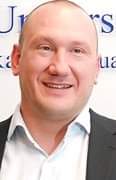

Facharzt für Orthopädie & Unfallchirurgie, Privatarzt für amerikanische Chiropraktik
Er absolvierte eine Research Fellowship am UCSF und eine SPortorthopädie Fellowship unter Prof Indelicato and der UF in Florida. Amerikanischer Chiropraktik machte er bei M. Styers am AIC / Hamburg.Dr. med. G. Wildenau hat umfangreiche, auch internationale, Erfahrungen in der Betreuung von Sportlern, unter anderen:
- American Football: Teamarzt Cologne Falcons
- Eishockey Oberliga: Teamarzt Harzer Falken
- 1. League Fussball AUS: Teamarzt Newcastle
- Taekwondo: Verbandsarzt NWTU
Daneben betreute Dr. Wildenau als Spielernotarzt die Mannschaft von Bayer 04 Leverkusen während der Champions League.
Veröffentlichungen
Expression of the CD44 variant isoform 5 in the human osteoarthritic knee joint: Correlation with radiological, histomorphological, and biochemical parameters
J Orthop Res. 2004 Jul;22(4):774-80
Abstract
PURPOSE:
The purpose of this study was to correlate expression of CD44v5 in osteoarthritic synovium, cartilage, and synovial fluid with radiographical, histomorphological, and biochemical data.
METHODS:
Cartilage and synovia specimens of 27 patients with osteoarthritis were histomorphologically assessed according to Mankin and Pelletier, respectively. Extended weight-bearing antero-posterior radiographs were evaluated according to Kellgren and Ahlback. Expression of membrane-bound CD44v5 was analyzed by immunohistochemistry and levels of soluble CD44v5 were determined by ELISA.
RESULTS:
Expression of CD44v5 in cartilage and synovia was detected in 67% and 59% of the patients, respectively. Immunohistochemical findings in cartilage correlated significantly with structural cartilage changes (p < 0.001), whereas no correlation was found between expression in synovia and inflammatory synovial changes. Additionally, no relationship was evident between CD44v5 expression and radiographical data, but expression in cartilage and synovium was significantly correlated with each other (p < 0.04). Surprisingly, expression of CD44v5 in both cartilage and synovia was negatively correlated with synovial fluid levels of TNFalpha (p < 0.03 and p < 0.02, respectively), and no association was evident with levels of IL-1beta.
CONCLUSIONS:
The data demonstrate expression of CD44v5 in osteoarthritic cartilage and synovia, probably independent of joint inflammation. But more importantly, expression of this receptor variant in cartilage seems to be strongly related to the degree of cartilage destruction.
Vergleichender Einsatz von Immunsensoren und Elisa-Technik zur Bestimmung von Myoglobin und H-Fatty Acid Binding Protein in Plasma und Harn zur Diagnostik von Trainingswirkungen: Schlußbericht des DARA-Projektes 50 WB 95552
Univ. Göttingen, Sportmedizin, 1998 - 102 Seiten 1998
Comparative use of immune sensors and ELISA technique for the determination of myoglobin and H-Fatty Acid Binding Protein in plasma and urine for the diagnosis of training effects: final report of the project DARA (German Space Agency) 50 WB 95552
Primary care for refugees in Germany – first data on demographics and reasons for treatment after the establishment of basic health care in refugee camps
Anästh Intensivmed 2015;56:654-660 Aktiv Druck & Verlag GmbH 26. Oktober 2015
Background: Due to current armed conflicts in the Middle East and Northern Africa, many European countries face increasing numbers of refugees. Germany is expecting about 800,000 refugees in 2015. After a long journey and associated distress, many of these refugees need medical care. Methods: During the observation period, data on treatment of refuges were unsystematically collected by physicians and assistants. Data on demographics and reasons for medical treatment were analysed.
Results: During the first three days of treatment in two different refugee camps, a total of 371 refugees were seen by doctors. 73% of these patients were male, 21% under the age of 18 years. Most of these patients reported having respiratory (30%) or skin dis-orders (19%). Scabies represented a further problem.
Conclusion: Experiences from the first three days have already outlined current problems (e.g. language problems) and approaches how to deal with them. In addition, it gives an overview of com-mon diseases during the first phase of treatment in refugee camps in Germany. It also showed the kind of challenges medical personnel are facing (e.g. correct documentation and registration of patients). Eventually sustainable solutions need to be implemented in order to assure that all refugees will have a broad and barrier-free access to adequate health care provisions.
ÄRZTE IN DERFLÜCHTLINGS-ERSTAUFNAHME: Frühe Versorgung ermöglichen: Der Aufbau ärztlicher Ambulanzen in Hamburg–ein erster Erfahrungsbericht
Deutsches Ärzteblatt 18. September 2015
In Hamburg leben bereits mehr als 7 000 Flüchtlinge in provisorischen Zentralen Erstaufnahmen. Täglich kommen rund 300 Neuankömmlinge hinzu. Bis zu einer ersten behördlichen Entscheidung über ihren Aufenthalt und den damit verbundenen Umzug in eine reguläre Wohnstätte vergehen häufig mehrere Monate. In dieser Zeit sollen die Flüchtlinge in den Einrichtungen mit dem Nötigen versorgt werden: Unterkunft, Kleidung, Essen und auch Medizin. Die Zustände in den Erstaufnahmen sind teilweise desolat und unterschreiten unzweifelhaft die Grenzen des Zumutbaren. Hilfsorganisationen und Behörden scheinen dem großen Andrang nicht gewachsen. Die Schlafplätze befinden sich zumeist in Zeltstädten oder Hallenanlagen. Hunderte Liegen stehen dicht an dicht, ohne Sichtschutz oder räumliche Abgrenzungsmöglichkeit. Auch die Zustände der Toiletten und Waschräume sind mangelhaft.Trotz der unhaltbaren Hygienesituation fand zunächst keine ärztliche Grundversorgung statt. Erst nach rund drei bis vier Monaten hat ein Asylbewerber (eingeschränkten) Anspruch auf kassenärztliche Versorgung. Die Bewohner führte wiederholt zu Demonstrationen und Protesten der Flüchtlinge und war mitverantwortlich für einen bisher in Deutschland beispiellosenAusbruch von Scabies. Daraufhin beauftragte die Innenbehörde einen privaten Träger mit der Errichtung ärztlicher Versorgungsstellen innerhalb der Erstaufnahmen. Bisher gelang im Auftrag der Behörde der Aufbau von fünf Ambulanzen. An den Standorten konnten
inzwischen mehr als 3 000 Patienten versorgt beziehungsweise Behandlungen durchgeführt werden.
In rund 40 Fällen erfolgte nach ambulanter Sichtung eine rettungsdienstliche Krankenhauseinweisung. Dies entspricht einem Rückgang um mehr als zwei Dritteln im Vergleich zu den drei Wochen vor Eröffnung der Ambulanzen
Evaluation von Relationen zwischen Trittfrequenzen und kardiopulmonalen Funktionsgrößen beim Radfahren - Ein Vergleich belastungs- und beanspruchungssensibler Kenngrößen
Leipziger Sportwissenschaftliche Beiträge. Jg. 40, 1999, Heft 1, S. 59-72. 1999
Evaluation of relations between cadence and
cardiopulmonary exercise variables in cycling - a comparison of load and
stress sensitive parameters
ORTHODOCS Wolfsburg
Hofekamp 11
38442 Wolfsburg
Telefon: 05362-5012454
E-Mail: info@orthodocs-wolfsburg.de

